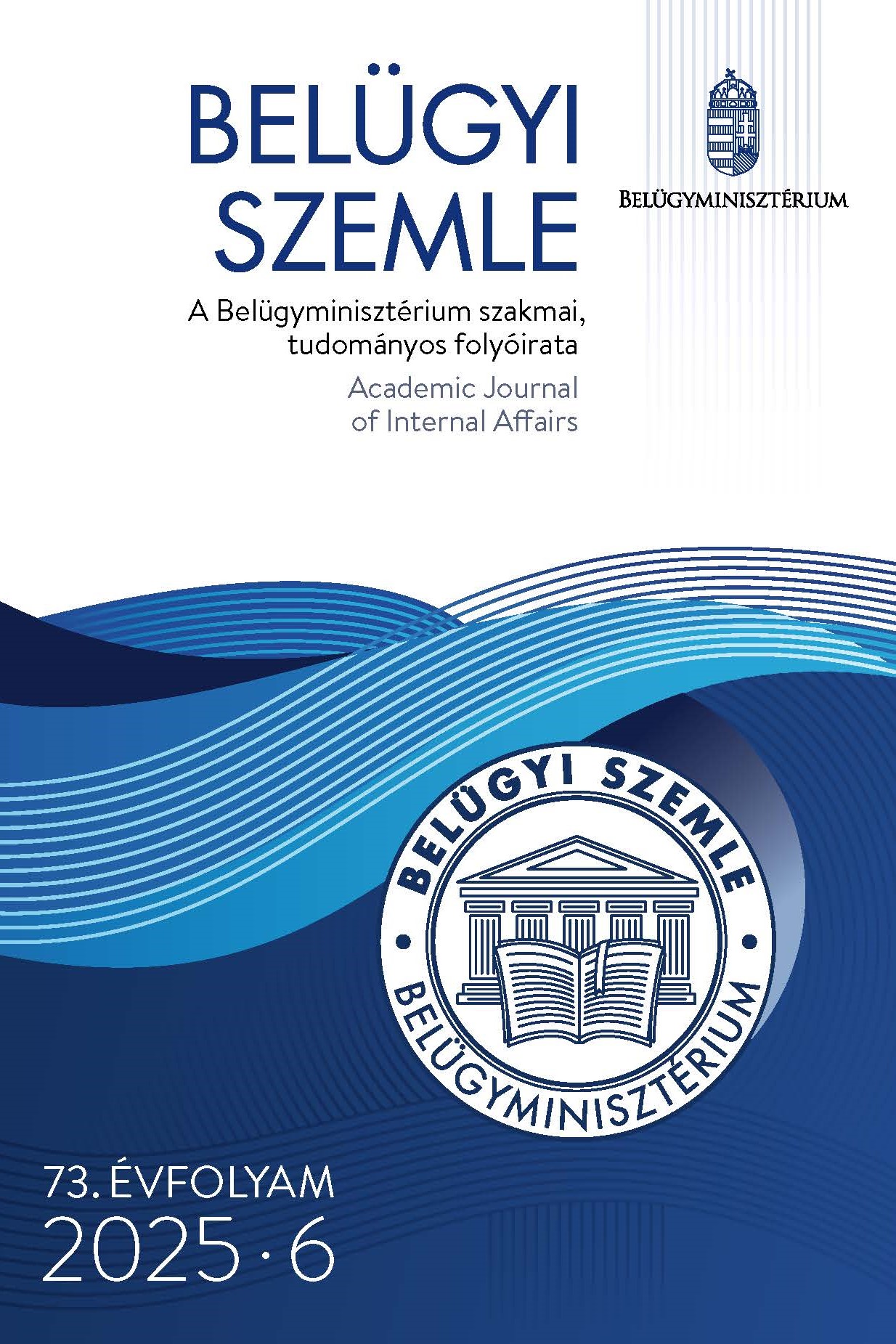Abstract
Aim: The Communications Service of the National Police Headquarters informed the media that body cameras were being tested by the police. The introduction of police body cameras is not only a technological innovation, but also a change that can significantly affect the organisational culture of law enforcement agencies. For this reason, the authors decided to examine the effect of camera footage in shaping the organisational culture of the police. In this study, the authors approach the practice of showing recordings from a sociological point of view, presenting both its advantages and disadvantages.
Methodology: The review and analysis of the relevant international literature, as well as domestic experiences and personal experiences gained during practical work, helped to process the topic. The authors approached the topic from its sociological aspect.
Findings: In the study, the authors came to the conclusion that there is enough research available regarding the new visibility and visibility, so it is essential to review and utilise body cameras before they are introduced in Hungary.
Value: The results of the investigation can be used not only in police work, but also in the education of law enforcement professionals.
References
Balla, J. (2019). Integritási kockázatok csökkentése a határrendészek körében. Nemzeti Közszolgálati Egyetem.
Brighenti, A. (2007). Visibility: A category for the social sciences. Current sociology, 55(3), 323–342.
Cullen, F. T., Link, B. G., Travis, L. F. & Lemming, T. (1983). Paradox in policing: A note on perceptions of danger. Journal of Police Science & Administration, 11(4), 457–462.
Deuchar, R., Crichlow, V. J. & Fallik, S. W. (2020). Cops in crisis?: Ethnographic insights on a new era of politicization, activism, accountability, and change in transatlantic policing. Policing and society, 30(1), 47–64. https://doi.org/10.1080/10439463.2019.1584197
Doyle, A. (2006). An alternative current in surveillance and control: Broadcasting surveillance footage of crimes. In Haggerty, K. D. & Ericson, R. V. (Eds.), The New Politics of Surveillance and Visibility (pp. 199–224). University of Toronto Press.
Dunham, R. G. & Alpert, G. P. (2010). The foundation of the police role in society. In Dunham, R. G., Alpert, G. P. & McLean, K. D., Critical issues in policing, contemporary readings (pp. 3–16). Waveland Press.
Farkas, J., Sallai, J. & Krauzer, E. (2020). The organisational culture of the police force. Internal Security, 12(1), 77–84. http://dx.doi.org/10.5604/01.3001.0014.3189
Farrar, T. (2013). Self-awareness to being watched and socially-desirable behavior: A field experiment on the effect of body-worn cameras on police use-of-force. Police Foundation.
Fassin, D. (2017). Boredom: Accounting for the ordinary in the work of policing (France). In Fassin, D. (Ed.), Writing the world of policing: The difference ethnography makes (pp. 269–292). University of Chicago Press. https://doi.org/10.7208/chicago/9780226497785.003.0013
Goldsmith, A. (2005). Police reform and the problem of trust. Theoretical criminology, 9(4), 443–470. https://doi.org/10.1177/1362480605057727
Goldsmith, A. J. (2010). Policing’s new visibility. The British journal of criminology, 50(5), 914–934. https://doi.org/10.1093/bjc/azq033
Haggerty, K. D. & Sandhu, A. (2014). The police crisis of visibility [Commentary]. IEEE technology and society magazine, 33(2), 9–12. http://dx.doi.org/10.1109/MTS.2014.2319912
Héder, K. (2021). A megfigyelés és megfigyeltség szubjektív aspektusai. Magyar Rendészet, 21(2), 143–160.
Holdaway, S. (1988). Blue jokes: Humour in police work. In Powell, C. & Paton, G. E. C. (Eds.), Humour in society: Resistance and control (pp. 106–122). Palgrave Macmillan. https://doi.org/10.1007/978-1-349-19193-2_6
Keesman, L. D. (2023). The showability of policing: How police officers’ use of videos in organizational contexts reproduces police culture. European Journal of Criminology, 20(3), 905–924. https://doi.org/10.1177/14773708221144826
Miller, K. (2016). Watching the watchers: Theorizing cops, cameras, and police legitimacy in the 21st century. In Deflem, M. (Ed.), The politics of policing: Between force and legitimacy (pp. 257–276). Emerald Group Publishing Limited. http://dx.doi.org/10.1108/S1521-613620160000021014
Newell, B. C. (2014). Crossing lenses: Policing’s new visibility and the role of "smartphone journalism" as a form of freedom-preserving reciprocal surveillance. University of Illinois Journal of Law, Technology & Policy, 13(1), 59–104.
Paoline III, E. A. (2003). Taking stock: Toward a richer understanding of police culture. Journal of criminal justice, 31(3), 199–214. https://doi.org/10.1016/S0047-2352(03)00002-3
Pogrebin, M. R. & Poole, E. D. (1988). Humor in the briefing room: A study of the strategic uses of humor among police. Journal of contemporary ethnography, 17(2), 183–210. https://doi.org/10.1177/089124188017002003
Punch, M. (1979). Policing the inner city: A study of Amsterdam’s Warmoesstraat. Springer.
Shearing, C. D. & Ericson, R. V. (1991). Culture as figurative action. British journal of sociology, 42(4), 481–506. https://psycnet.apa.org/doi/10.2307/591444
Skolnick, J. H. & Fyfe, J. J. (1993). Above the law: Police and the excessive use of force. Free Press.
Thompson, J. B. (2005). The new visibility. Theory, culture & society, 22(6), 31–51. https://doi.org/10.1177/0263276405059413
Van Hulst, M. (2013). Storytelling at the police station: The canteen culture revisited. British journal of criminology, 53(4), 624–642. http://dx.doi.org/10.1093/bjc/azt014
Van Maanen, J. (1973). Observations on the making of policemen. Human organization, 32(4), 407–418.
Waddington, P. A. (1999). Police (canteen) sub-culture. An appreciation. British journal of criminology, 39(2), 287–309. https://doi.org/10.1093/bjc/39.2.287
Westley, W. A. (1970). Violence and the police: A sociological study of law, custom, and morality. MIT Press.

This work is licensed under a Creative Commons Attribution-NonCommercial-NoDerivatives 4.0 International License.
Copyright (c) 2025 Academic Journal of Internal Affairs

